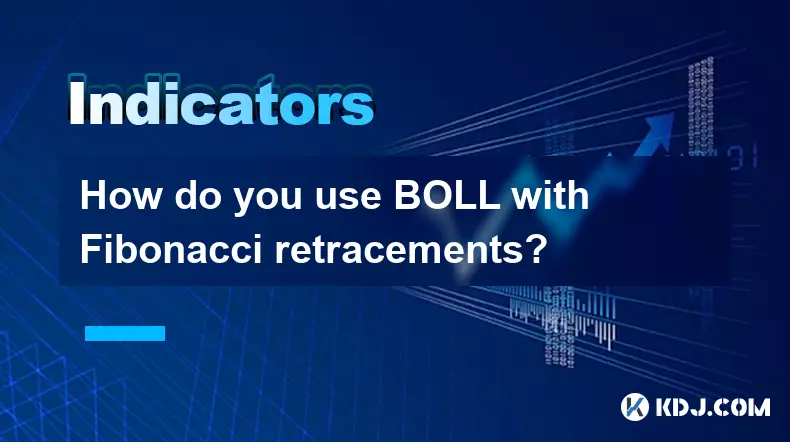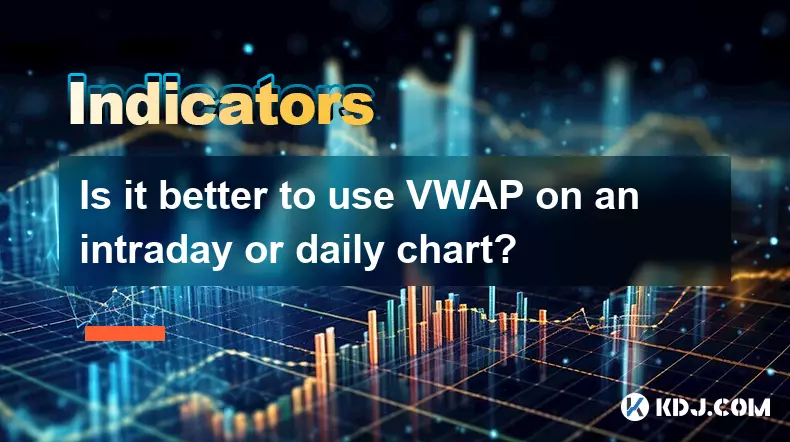-
 bitcoin
bitcoin $110918.433029 USD
-1.69% -
 ethereum
ethereum $3996.872473 USD
-2.43% -
 tether
tether $1.000594 USD
0.00% -
 bnb
bnb $1178.871834 USD
-2.38% -
 xrp
xrp $2.413973 USD
-3.47% -
 solana
solana $194.341461 USD
-4.24% -
 usd-coin
usd-coin $0.999963 USD
-0.03% -
 tron
tron $0.320092 USD
0.92% -
 dogecoin
dogecoin $0.196919 USD
-3.42% -
 cardano
cardano $0.669585 USD
-3.63% -
 hyperliquid
hyperliquid $37.485952 USD
-3.58% -
 ethena-usde
ethena-usde $1.000026 USD
-0.02% -
 chainlink
chainlink $18.018220 USD
-5.13% -
 bitcoin-cash
bitcoin-cash $523.879267 USD
-2.41% -
 stellar
stellar $0.324655 USD
-3.67%
How do you use BOLL with Fibonacci retracements?
Combining Bollinger Bands and Fibonacci retracements enhances crypto trading accuracy by aligning volatility signals with key support/resistance levels for high-probability entries.
Oct 11, 2025 at 05:37 am

Combining BOLL and Fibonacci Retracements in Crypto Trading
Traders in the cryptocurrency market often seek reliable tools to identify potential reversal points and trend continuations. The combination of Bollinger Bands (BOLL) and Fibonacci retracements offers a powerful analytical framework. By integrating volatility measurements with key support and resistance levels, traders can refine their entry and exit strategies.
Understanding the Synergy Between BOLL and Fibonacci Levels
1. BOLL reflects market volatility through its upper, middle, and lower bands, while Fibonacci retracements highlight psychological price zones such as 38.2%, 50%, and 61.8%.- When price approaches a Fibonacci retracement level and simultaneously touches or crosses a Bollinger Band, it may signal a high-probability reversal.
- A confluence between the 61.8% Fibonacci level and the upper Bollinger Band in an uptrend could indicate overbought conditions.
- In downtrends, price meeting the 38.2% or 50% Fibonacci level at the lower Bollinger Band might suggest temporary exhaustion.
- The middle Bollinger Band (typically the 20-period moving average) often aligns with the 50% retracement level, reinforcing its significance as dynamic support or resistance.
Practical Application in Cryptocurrency Markets
1. During strong bullish momentum in Bitcoin, pullbacks toward the 61.8% Fibonacci retracement that also touch the middle Bollinger Band can serve as low-risk entry points.- If Ethereum’s price reaches the upper Bollinger Band while simultaneously aligning with the 38.2% Fibonacci extension, it may foreshadow a short-term top.
- Volume spikes near these confluences enhance the reliability of the signal, especially in highly liquid pairs like BTC/USDT.
- Traders often wait for candlestick confirmation—such as doji or engulfing patterns—before acting on the combined signal.
- Adjusting the BOLL settings (e.g., using a 50-period SMA with 2.5 standard deviations) can better suit the volatile nature of altcoins when paired with Fibonacci levels.
Managing Risk with Combined Indicators
1. Stop-loss orders can be placed just beyond the nearest Fibonacci level outside the Bollinger Band to limit downside risk.- For long positions initiated at the lower band and 61.8% retracement, placing stops below the 78.6% level provides a strategic buffer.
- In ranging markets, false breakouts beyond Bollinger Bands near Fibonacci extremes are common; tight risk management prevents significant drawdowns.
- Position sizing should account for increased volatility during major news events, even if technical confluence appears favorable.
- Backtesting this strategy across multiple crypto assets reveals that Litecoin and Solana show stronger responses to BOLL-Fibonacci setups than more erratic memecoins.
Frequently Asked Questions
What timeframes work best for combining BOLL and Fibonacci in crypto trading?The daily and 4-hour charts provide optimal balance between noise reduction and actionable signals. Shorter timeframes like 15-minute charts generate too many false triggers due to extreme volatility.
Can BOLL and Fibonacci be used during sideways markets?Yes, but with caution. In consolidation phases, price tends to oscillate between the bands and shallow retracement levels. Focus shifts to mean reversion trades within the range.
How do you adjust Fibonacci levels when there’s a gap or spike in price?Use the most recent significant swing high and low, ignoring anomalous wicks. Gaps caused by exchange imbalances or flash crashes should not define Fibonacci reference points.
Is it necessary to use volume indicators alongside BOLL and Fibonacci?While not mandatory, volume adds confirmation. A breakout or rejection at a confluence zone supported by rising volume increases the probability of follow-through movement.
Disclaimer:info@kdj.com
The information provided is not trading advice. kdj.com does not assume any responsibility for any investments made based on the information provided in this article. Cryptocurrencies are highly volatile and it is highly recommended that you invest with caution after thorough research!
If you believe that the content used on this website infringes your copyright, please contact us immediately (info@kdj.com) and we will delete it promptly.
- Steve Jobs, Innovation, and a U.S. Coin: A New Chapter in American Iconography
- 2025-10-16 15:05:11
- Trump, Challenge Coins, and Netizens: A Digital Deep Dive
- 2025-10-16 14:25:17
- Binance's Gopax Gambit: A New York Minute on Crypto's Korean Conquest
- 2025-10-16 15:05:11
- CZ, Kaspa, and Binance: Unpacking the Latest Crypto Buzz
- 2025-10-16 14:45:16
- Bitcoin, Yield ETFs, and ARK Invest: A New Era for Crypto Investing?
- 2025-10-16 15:25:29
- Crypto's Shifting Sands: BNB on Coinbase, Ripple's Swell, and MoonBull's Rise – A New Yorker's Take
- 2025-10-16 15:10:00
Related knowledge

What's the main difference between VWAP and TWAP?
Oct 12,2025 at 11:54am
Understanding VWAP and Its Role in Crypto Trading1. Volume Weighted Average Price (VWAP) is a trading benchmark that calculates the average price of a...

How do you identify exhaustion moves using VWAP and its bands?
Oct 12,2025 at 08:00am
Understanding the Role of Decentralized Exchanges in Crypto Trading1. Decentralized exchanges (DEXs) operate without a central authority, allowing use...

Is it better to use VWAP on an intraday or daily chart?
Oct 15,2025 at 02:01am
Intraday Trading and the Role of VWAP1. Intraday traders frequently rely on VWAP (Volume Weighted Average Price) as a dynamic benchmark for assessing ...

How do you use VWAP to scale in and out of positions?
Oct 14,2025 at 02:19am
Understanding VWAP as a Dynamic Benchmark1. The Volume Weighted Average Price (VWAP) is not just an indicator—it functions as a dynamic benchmark that...

What are the main advantages of using VWAP over EMA?
Oct 11,2025 at 02:18am
Main Advantages of Using VWAP Over EMA1. Volume-Weighted Average Price (VWAP) incorporates trading volume into its calculation, offering a more accura...

How do you use VWAP on different chart types like Heikin Ashi?
Oct 11,2025 at 05:01pm
Understanding VWAP in the Context of Heikin Ashi Charts1. The Volume Weighted Average Price (VWAP) is a powerful analytical tool commonly used by trad...

What's the main difference between VWAP and TWAP?
Oct 12,2025 at 11:54am
Understanding VWAP and Its Role in Crypto Trading1. Volume Weighted Average Price (VWAP) is a trading benchmark that calculates the average price of a...

How do you identify exhaustion moves using VWAP and its bands?
Oct 12,2025 at 08:00am
Understanding the Role of Decentralized Exchanges in Crypto Trading1. Decentralized exchanges (DEXs) operate without a central authority, allowing use...

Is it better to use VWAP on an intraday or daily chart?
Oct 15,2025 at 02:01am
Intraday Trading and the Role of VWAP1. Intraday traders frequently rely on VWAP (Volume Weighted Average Price) as a dynamic benchmark for assessing ...

How do you use VWAP to scale in and out of positions?
Oct 14,2025 at 02:19am
Understanding VWAP as a Dynamic Benchmark1. The Volume Weighted Average Price (VWAP) is not just an indicator—it functions as a dynamic benchmark that...

What are the main advantages of using VWAP over EMA?
Oct 11,2025 at 02:18am
Main Advantages of Using VWAP Over EMA1. Volume-Weighted Average Price (VWAP) incorporates trading volume into its calculation, offering a more accura...

How do you use VWAP on different chart types like Heikin Ashi?
Oct 11,2025 at 05:01pm
Understanding VWAP in the Context of Heikin Ashi Charts1. The Volume Weighted Average Price (VWAP) is a powerful analytical tool commonly used by trad...
See all articles


























![Web3 Crypto Market Morning Report: The market is in decline, altcoins have fallen by more than 5%, Binance compensation has been received, and Memes on the Bnb chain have collectively plummeted [Vic TALK Issue 1444] Web3 Crypto Market Morning Report: The market is in decline, altcoins have fallen by more than 5%, Binance compensation has been received, and Memes on the Bnb chain have collectively plummeted [Vic TALK Issue 1444]](/uploads/2025/10/16/cryptocurrencies-news/videos/web-crypto-market-morning-report-market-decline-altcoins-fallen-binance-compensation-received-memes-bnb-chain-collectively-plummeted-vic-talk-issue/68f043c9c8b44_image_500_375.webp)















































